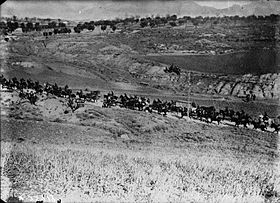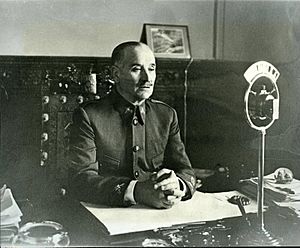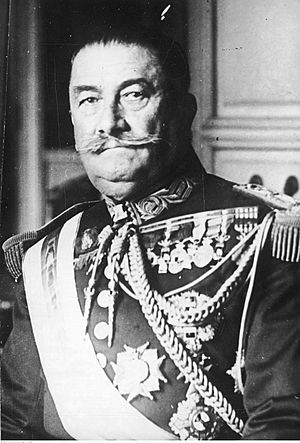Jaca uprising facts for kids

Government troops advance towards Jaca
|
|
| Native name | Sublevación de Jaca |
|---|---|
| Date | 12–13 December 1930 |
| Location | Jaca, Spain |
| Type | Military revolt |
| Target | Overthrow the Spanish monarchy |
| Organised by | Fermín Galán Ángel García Hernández |
| Outcome | Suppressed |
The Jaca uprising (Spanish: Sublevación de Jaca) was a military revolt that happened on December 12–13, 1930. It took place in Jaca, a town in Huesca, Spain. The main goal of this uprising was to remove the King of Spain from power.
This revolt started too early and was not well organized. Because of this, it was quickly stopped by the government. Its leaders were either executed or put in prison. However, the Jaca uprising caused a lot of political trouble. This trouble eventually led to Spain becoming a republic, called the Second Spanish Republic, just a few months later.
Contents
Why it Happened
The Jaca uprising began in the military base of Jaca, a small town in the Pyrenees mountains of Aragon. It happened during a time when many people in Spain were unhappy. For six years, Spain had been ruled by a dictatorship, first under Miguel Primo de Rivera and then under Dámaso Berenguer. People wanted change.
This revolt was also part of bigger movements happening across Europe. After World War I and the Russian Revolution, many Europeans wanted their governments to change.
The idea for the Jaca uprising came from a meeting in August 1930 called the Pact of San Sebastián. At this meeting, politicians who wanted a republic joined forces. Their goal was to remove King Alfonso XIII of Spain and create the Second Spanish Republic. They formed a group called the National Revolutionary Committee (CRN). This group would act as a temporary government for the new republic.
Workers' unions, like the Unión General de Trabajadores (UGT) and the Confederación Nacional del Trabajo (CNT), agreed to help. They planned to go on strike to support the military if they rebelled.
The Plan's Leader
Captain Fermín Galán was the main organizer of the uprising. He was sent to Jaca in June 1930. He wanted to connect a military revolt with the political groups that were against the dictatorship.
Galán talked with leaders from the CNT in Zaragoza and Huesca. He became good friends with a union leader named Ramón Acín. When the CRN was formed in October 1930, Galán went to Madrid to meet its leaders. They made him the CRN's representative in Aragon.
From then on, Galán pushed the CRN to support a military uprising across the country, along with public protests. But the CRN kept delaying the date, which frustrated him.
Many officers and soldiers in Jaca helped plan the revolt. Some civilians also joined in. The date of December 12, 1930, was set. But then the CRN changed it to December 15. Santiago Casares Quiroga, a CRN representative, knew about the delay. He arrived in Jaca the night before, but he didn't tell Galán. Casares thought Galán already knew about the new plan.
The Revolt Begins
Events in Jaca
Captain Galán started the uprising in Jaca in the early hours of December 12. The revolt began in the La Victoria barracks and quickly spread to other military bases.
Around 5:00 a.m., a group of officers called out the troops. They arrested the military governor. Some people who resisted were killed. The rebels took control of important places like the telephone exchange, post office, and railway station. At 11:00 a.m., they officially announced the Republic at Jaca city hall. They said they were acting "on behalf of the Revolutionary Provisional Government."
Pío Díaz Pradas took over the mayor's office. This was to show that the new government would be run by civilians, not just the military.
At the same time, two groups of soldiers were formed to march to Huesca. One group, led by Galán, would go by road. The other, led by Salvador Sediles, would go by train. The rebels expected their journey to be a triumphant march of freedom. But there were delays in getting transportation, so they didn't leave Jaca until 3:00 p.m.
March to Huesca
Bad weather and the slow speed of the march worked against the rebels. Around 5:00 p.m., General Manuel de las Heras and some Civil Guards met Galán's group near Anzánigo. He tried to stop the 500 rebel soldiers by force. Some shots were fired, and General de las Heras was wounded. But the rebel group kept moving slowly.
When they reached Ayerbe, the rebels took control of the telephone and telegraph offices. They also announced the Republic there. The group of 300 soldiers led by Sediles found that the railway tracks were removed at Riglos. So, they walked from there to join Galán's group in Ayerbe. The combined force then moved towards Huesca. They expected other soldiers in Huesca to join their rebellion, as planned.
Defeat at Cillas
The uprising was stopped by officers from the 5th Military Regiment, based in Zaragoza. The military leaders in Zaragoza quickly organized a counterattack. General Joaquim Gay Borràs took over from the wounded General de las Heras.
On the evening of December 12, government troops from Zaragoza and Huesca began to move towards the hills of Cillas. These government forces were large and had artillery, tanks, and machine guns. At dawn on December 13, 1930, about 3 kilometers from Huesca, the rebels faced the government army.
Galán had to choose between fighting or trying to talk. He believed that many of the opposing soldiers were secretly on their side. So, he chose to negotiate. Captain Ángel García Hernández and Captain Salinas drove a car with a white flag across the line. When they arrived, they were immediately arrested. Then, the government troops started firing at the rebels.
Galán refused to order his men to fight back, saying "brothers cannot fight each other." He ordered a retreat instead. Three rebels died, and 25 were wounded. The rebel force fell apart. Some soldiers went back to Jaca, some were arrested, and some tried to escape. A few managed to hide in big cities like Zaragoza, Barcelona, and Madrid until the Republic was declared. Galán willingly surrendered in Biscarrués with other rebels. He arrived in Ayerbe around 10:00 p.m. on December 13.
After the Battle
In Zaragoza, the capital of Aragon, a general strike was announced on the evening of December 12. But the government troops had already been sent to Huesca by train. So, it was too late for the railway workers to stop them. By the morning of December 13, when the strike began, the rebels had already surrendered.
Strikes also started in other towns. Revolutionary committees were set up to try and organize the movement.
The military reacted quickly. Troops from Zaragoza occupied Gallur early on December 14. Civil Guards stopped unrest in other towns. In Gallur, Civil Guards arrested union leaders. When people protested, the Civil Guards fired shots, but luckily no one died.
On December 14, Captains Galán and García Hernández were quickly put on trial by the military. They were sentenced to death. Other officers received life in prison. Galán and García Hernández were shot in Huesca at 3:00 p.m. on December 14, 1930. This execution made many people very angry at the government.
On December 15, strikes spread across almost all of Spain, except Madrid. Most members of the CRN and union leaders were arrested. Many military officers who were part of the conspiracy were watched closely. The bigger uprising planned for December 15 failed.
General Gonzalo Queipo de Llano and Major Ramón Franco did manage to take over Cuatro Vientos Airport for a few hours. But when they saw that loyal government troops were coming and no strike had started in Madrid, they fled to Portugal. The socialists in Madrid didn't strike because they didn't trust the officers to act. And the officers didn't act because they weren't supported by a strike and street protests.
General Berenguer resigned two months after the revolt. He was replaced by Admiral Aznar. In March 1931, many of the rebel officers and soldiers were put on trial and sentenced. This included soldiers in Jaca who didn't fight but also didn't try to stop the rebels. Sediles was sentenced to death, but he was pardoned before big protests spread across Spain. The regular soldiers who rebelled were sent to military bases in North Africa.
What Happened Next
Seven days after Galán was executed, a play called El gran teatro del mundo was performed in Madrid. The audience saw it as having a revolutionary message. When one character said, "if we have no King, we will be better off," the audience cheered loudly. Manuel Azaña, a future president, wrote that the King's government made a huge mistake by executing Galán and García Hernández. He believed this mistake greatly helped lead to the end of the monarchy.
Public anger grew. Admiral Aznar had to call for local elections in April 1931. In these elections, republican candidates won in all major cities and most provincial capitals. Two days later, on April 14, 1931, the republican leaders declared Spain a republic. Niceto Alcalá-Zamora became its first leader.
It became clear that the army leaders would not support the King. So, he left Spain that night. Captains Salinas and Sediles, who were involved in the Jaca uprising, became important left-wing republican leaders in 1931 and 1932. Galán and García Hernández became heroes of the new Second Republic. Their pictures were displayed in government offices and homes across Spain. However, the new leaders of the Republic had not done much to support the Jaca uprising. They also didn't share its revolutionary goals.
At the start of the Spanish Civil War in August 1936, many people who were involved in the Jaca uprising were executed. In 2010, the town of Jaca put up a memorial for 400 victims of these executions. In December 2007, a documentary about the uprising, La sublevación de Jaca. Los capitanes del frío, was released.
Images for kids
See also
 In Spanish: Sublevación de Jaca para niños
In Spanish: Sublevación de Jaca para niños






